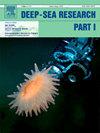On Anguillosyllis cf. hessleri Maciolek, 2020 – A species complex from the Clarion-Clipperton zone, abyssal central Pacific
IF 2.1
3区 地球科学
Q2 OCEANOGRAPHY
Deep-Sea Research Part I-Oceanographic Research Papers
Pub Date : 2025-04-02
DOI:10.1016/j.dsr.2025.104453
引用次数: 0
Abstract
The benthic annelid fauna of polymetallic nodule fields in the eastern Clarion-Clipperton Zone (CCZ) has recently been the subject of taxonomic investigations aiming to document the biodiversity of this region. While investigating the annelids, a particularly high diversity was discovered within the genus Anguillosyllis Day, 1963 using a combination of morphological and molecular approaches. Initially, 38 specimens of Anguillosyllis were assigned to the known CCZ species Anguillosyllis hessleri Maciolek, 2020 based on morphological examination, including examination of the type specimen. However, our genetic data revealed that these specimens represent four distinct lineages (putative species) based on COI and 16S markers. Further morphological investigation using SEM revealed a complex structure of the prostomium, which could potentially differentiate these lineages. However, as no molecular or SEM data are available from the type specimen of A. hessleri, we cannot ascertain which, if any, of these lineages represent the known species described by Maciolek (2020). Thus, currently, we can only assign CCZ specimens to Anguillosyllis cf. hessleri and further distinguish the lineages by assigning each a unique code in the form of “NHM_####”. The SEM observations are the first reported for Anguillosyllis, revealing new taxonomic characters that may be used to disentangle the A. hessleri species complex and be of use in taxonomy of Anguillosyllis in general.
关于中太平洋深海Clarion-Clipperton带的anguillosilis cf. hessleri Maciolek, 2020 -一个物种复群
近年来,我国对克拉里昂-克利珀顿带东部多金属结核区底栖环节动物区系进行了分类研究,旨在记录该地区的生物多样性。在调查环节动物时,使用形态和分子方法相结合的方法在1963年的anguillosilis Day中发现了特别高的多样性。最初,基于形态学检查(包括模式标本检查),将38个鳗鲡标本归属于已知的CCZ物种anguillosilis hessleri Maciolek, 2020。然而,我们的遗传数据显示,基于COI和16S标记,这些标本代表了四个不同的谱系(假定的物种)。利用扫描电镜进一步形态学研究发现了一个复杂的原口结构,这可能是区分这些谱系的潜在因素。然而,由于没有从A. hessleri模式标本中获得分子或扫描电镜数据,我们无法确定这些谱系中哪一个(如果有的话)代表Maciolek(2020)描述的已知物种。因此,目前我们只能将CCZ标本归属于鳗鲡(anguillosilis cf. hessleri),并以“NHM_####”的形式为每个谱系分配一个独特的代码,以进一步区分谱系。这是第一次对鳗鲡进行扫描电镜观察,揭示了新的分类特征,可能用于解开鳗鲡种复合体,并在一般的分类中使用。
本文章由计算机程序翻译,如有差异,请以英文原文为准。
求助全文
约1分钟内获得全文
求助全文
来源期刊
CiteScore
4.60
自引率
4.20%
发文量
144
审稿时长
18.3 weeks
期刊介绍:
Deep-Sea Research Part I: Oceanographic Research Papers is devoted to the publication of the results of original scientific research, including theoretical work of evident oceanographic applicability; and the solution of instrumental or methodological problems with evidence of successful use. The journal is distinguished by its interdisciplinary nature and its breadth, covering the geological, physical, chemical and biological aspects of the ocean and its boundaries with the sea floor and the atmosphere. In addition to regular "Research Papers" and "Instruments and Methods" papers, briefer communications may be published as "Notes". Supplemental matter, such as extensive data tables or graphs and multimedia content, may be published as electronic appendices.

 求助内容:
求助内容: 应助结果提醒方式:
应助结果提醒方式:


